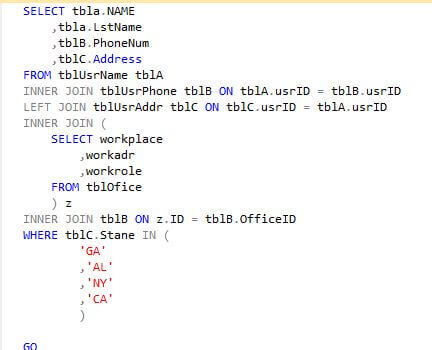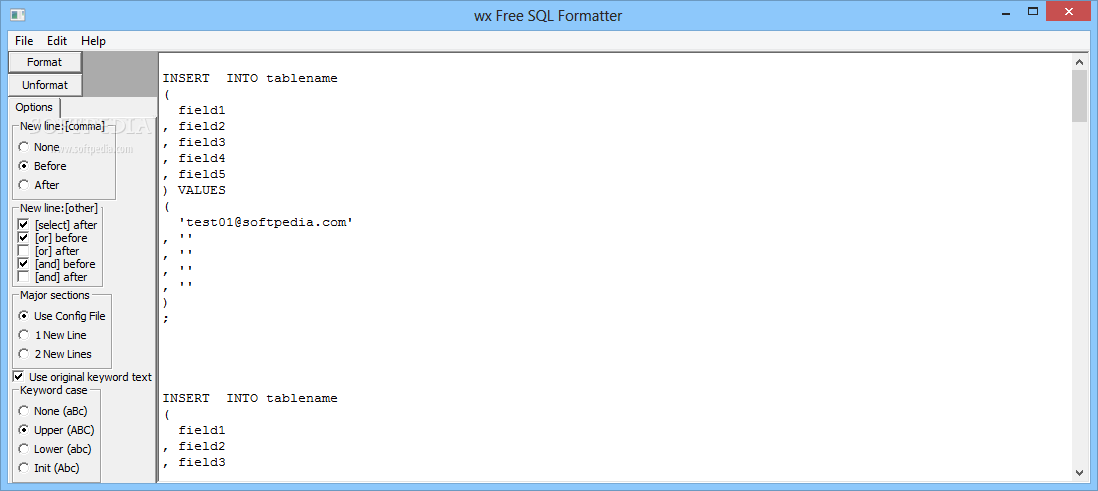
- SQL QUERY FORMATTER HOW TO
- SQL QUERY FORMATTER INSTALL
- SQL QUERY FORMATTER PATCH
You can follow the changes introduced by each version in our CHANGELOG How to contribute New documentation, refactoring / maintenance of code and admin tasks do not change the versions.
We increase x3 (the patch version) if we fix a bug. We increase x2 (the minor version) if we introduce a new feature. 0.5.1) mean that the package is not stable yet and therefore every new feature could be a breaking change Exception: Versions with 0 at the beginning (e.g. We increase x1 (the major version) if we introduce breaking changes. We use three digits separated by points x1.x2.x3, e.g. We version our package via semantic versioning, i.e., Everything not being a query of the form CREATE. Subqueries are also properly indented, e.g. This is a very nice, easy example but things can become more complicated if comments come into play WHERE field1 = 1 and field2 <= 2 or field3 = 5 ORDER BY field1 If you do not want to get some query formatted in your SQL file then you can use the marker /*skip-formatter*/ in your query to disable formatting for just the corresponding query from sql_formatter.format_file import format_sql_commandsįield1 = 'a' then 1 else 0 end as case_field, Select field1, field2 from (select field1,įield3 from table1 where a=1 and b>=100)) The formatter is also robust against nested subqueries print(format_sql( """ Join (select asdf, qwer2 from table2 where qwer2 = 1) as b (select asdf, qwer, from table1 where asdf = 1) as a Select asdf, cast(qwer as numeric), - some comment It can even deal with subqueries and it will correct my favourite simple careless mistake (comma at the end of SELECT statement before of FROM) for you on the flow :-) print(format_sql( """ LEFT JOIN table2 as b - and here a comment core import format_sqlĬREATE OR REPLACE TABLE mytable AS - mytable example Then you can use this package to format it so that it is better readable from sql_formatter. To exemplify the formatting let's say you have a SQL query like this example_sql = """Ĭreate or replace table mytable as - mytable example Or repos: - repo: local hooks: - id: sql_formatter name: SQL formatter language: system entry: sql-formatter -max-line-length=50 files: \.sql$įor a custom maximum line length truncation of e.g. pre-commit-config.yaml file: repos: - repo: local hooks: - id: sql_formatter name: SQL formatter language: system entry: sql-formatter files: \.sql$ If you want to install sql-formatter locally and use that instead of using pre-commit's default environment, set repo: local in your. pre-commit-config.yaml: repos: - repo: rev: master hooks: - id: sql_formatter To add sql-formatter as a hook to your pre-commit configuration to format your SQL files before commit, just add the following lines to your. After installation and configuration pre-commit will run your hooks before you commit any change. Pre-commit is a nice development tool to automatize the binding of pre-commit hooks. Sql-formatter sql_file.sql -max-line-length=50 Usage with pre-commit You can control the maximum length line using e.g.

The default maximum line length is 82 after line stripping. The sql_formatter will try to truncate too long lines in the SELECT clause for either Sql-formatter -r "*.sql" Controlling maximum length line via truncation

To format all your SQL files recursively use You can also format all your SQL-files via Conda install -c pablormira sql_formatter How to useįormat your SQL files via the command line






 0 kommentar(er)
0 kommentar(er)
